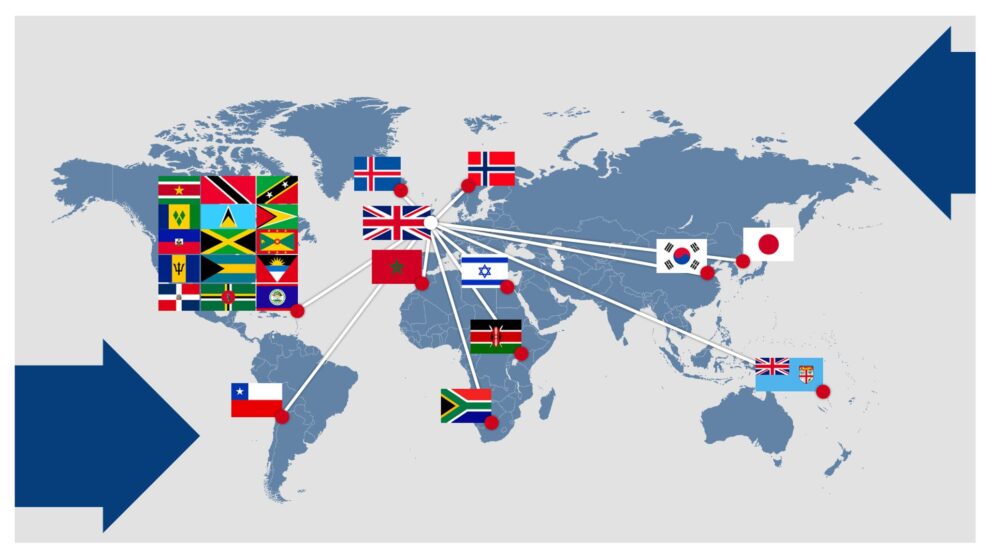After years of negotiation, the United Kingdom has at last established its post-Brexit relationship with the European Union on research. Scientists had been in limbo since the Brexit ‘transition period’ ended in 2021. This month, they welcomed the news that the United Kingdom will rejoin Horizon Europe — the EU’s flagship €95-billion (US$101-billion) research-funding programme — as an associate member (see ‘A new era’). This means that UK researchers will have access to grants and be able to collaborate with colleagues in member and associate-member countries.
The country has also renewed its participation in some other EU projects, such as the Earth-observation programme Copernicus. In other areas, the United Kingdom will forge its own path. It will no longer participate in the European Atomic Energy Community, or Euratom, for example. Nature lays out the United Kingdom’s post-Brexit involvement with pan-European science projects.
Research funding: the UK and Horizon Europe
The United Kingdom has rejoined Horizon Europe as an associate member until the end of the programme’s seven-year term in 2027. From January 2024, UK-based scientists will again be able to access and lead prestigious European Research Council (ERC) grants. UK researchers can now apply to ongoing grant calls concerning projects that will start next year.
But as a non-EU member, the United Kingdom will have no say on governance matters for Horizon. There are also other restrictions on UK participation: for example, UK researchers might not be able to be part of projects that involve national-security considerations. This will be decided on a case-by-case basis.
After June 2020, UK recipients of ERC grants had to either move to an EU country or reject the grant and receive UK guarantee funding of the same value. That money could be used only in the United Kingdom. The United Kingdom will pay an average of €2.43 billion a year into Horizon. Negotiators calculated this amount on the basis of UK gross domestic product and a formula that the EU uses for other ‘third party’ countries involved with Horizon. Payments will probably be made twice a year.
There is a rebalancing mechanism in case the United Kingdom receives more in grant money than it puts in, or pays in more than it receives. This isn’t the same in both directions: if the United Kingdom wins 8% or more in funds above what it paid in, it needs to pay them back. If it puts in 16% or more on top of what it gets, the EU will pay a rebate. Negotiations over these figures are thought to have contributed to the delay in finalizing the deal. The United Kingdom has historically been a significant beneficiary of ERC grants, but figures show that since the referendum in 2016, its share has dropped off (see ‘Brexit effect’).
Earth observation: Copernicus
The United Kingdom has also rejoined Copernicus — the EU’s Earth-observation and climate-monitoring programme. Copernicus monitors the land, oceans, atmosphere and climate using ground- and space-based instruments, including the Sentinel satellites. Copernicus services will be extended to cover UK territory, and UK users will have access to all the programme’s data.
As part of the deal, the United Kingdom will contribute around €154 million per year for Copernicus membership, on top of its Horizon Europe payments (see ‘Money matters’). UK companies and researchers can bid for contracts to run data-collection services and provide consultation expertise for monitoring and training. They can also participate in consortia that bid together. They are allowed to bid for programmes that start from 1 January 2024, under the same terms as EU member states — with restrictions for some security-related areas.
Many researchers say they couldn’t rejoin Copernicus soon enough. Jonathan Bamber, a physicist at the University of Bristol, UK, says that in 2022 he won ERC ‘follow on’ funding to develop his project for the market. At the time, UK researchers were ineligible for ERC funds, so Bamber took up guarantee funding provided by UK Research and Innovation (UKRI). He wanted to apply for more money from the European Innovation Council (EIC), but wasn’t able to do so. “Because [our funds] come from UKRI we cannot apply to the EIC for this,” Bamber says. “It’s actually super frustrating.”
Drug regulation: the EMA and the MHRA
Brexit meant that the United Kingdom left the EMA, which regulates drugs and medical devices in EU member states and was previously based in London. Pharmaceutical companies submit evidence of the safety and efficacy of their products to the EMA, which moved its headquarters to Amsterdam in 2019.
From 1 January 2021, the existing UK Medicines and Healthcare products Regulatory Agency (MHRA) took the reins of pharmaceutical regulation in England, Wales and Scotland. Drugs approved by the EMA before Brexit are still authorized in the United Kingdom. But drug companies seeking new approvals must now submit separate applications to the EMA and MHRA.
The evidence required is the same for both agencies, and the MHRA can look to EMA approvals to fast-track its authorizations. This procedure is outlined in the European Commission Decision Reliance Procedure (ECDRP) for the MHRA. The MHRA is working on an international recognition framework to replace the ECDRP. It will seek to add collaboration with nations including Australia and Canada from January 2024.
Data sharing and security
Research programmes that rely on the international data exchange have faced uncertainty since the Brexit vote (see ‘Seven years of turmoil’). Despite agreements, concerns remain about data sharing between UK and EU researchers. “Brexit is an extra layer of complication to something that is already complicated,” says Claudia Allemani, co-principal investigator of CONCORD, a cancer-tracking programme led by the London School of Hygiene & Tropical Medicine.
In the EU, information sharing and storage is governed by the General Data Protection Regulation (GDPR). After Brexit, the United Kingdom enshrined a version of this law and, in June 2021, the European Commission adopted an ‘adequacy decision’, recognizing that data gathered in the United Kingdom complies with the GDPR. “We were very lucky that that happened,” says Michel Coleman, Allemani’s CONCORD co-principal investigator.
But despite the adequacy decision, Brexit still poses challenges for data sharing. One concern is that the United Kingdom will change its data-protection rules so that they no longer comply with GDPR, and the commission could revoke its adequacy decision. “That would mean our partners in Europe would not want to send us data unless we established individual contracts with all of them,” says Coleman. In 2024, the commission will be able to extend the UK adequacy decision for four years; if this doesn’t happen, the decision will expire in June 2025.
“Participation in Horizon only highlights the importance of maintaining adequacy with GDPR,” says Sarion Bowers, head of policy at the Wellcome Sanger Institute, a genomic research centre near Cambridge, UK. “However, there is a need within Europe to better harmonize GDPR, particularly around health data and research,” says Bowers. This creates barriers not only for UK researchers, but also for EU researchers trying to collaborate with each other.
Euratom and ITER
One major disappointment of the research deal was that the United Kingdom will not rejoin Euratom, a programme complementary to Horizon Europe that funds nuclear research in areas including fusion, and regulates the use of nuclear energy in EU states. The UK government will implement its own fusion-energy strategy, and said on 7 September that it will invest up to £650 million (US$807 million) in this field by 2027. UK academics welcome the funding, says a spokesperson for the UK Atomic Energy Authority (UKAEA) in Abingdon. So does the private sector, owing to its focus on commercializing fusion energy, says Nick Walkden, UK director of the Fusion Industry Association. There is no information yet on when and how researchers will be able to apply for this funding. Still, the investment should attract highly trained people to build the growing UK fusion-research industry, says Kate Lancaster, a plasma physicist at the University of York, UK.
But future UK involvement with ITER — an international project that involves dozens of countries and aims to build the world’s largest ‘tokamak’ fusion reactor in France — is unclear. The United Kingdom was part of the experiment through its Euratom membership. The UKAEA is looking to continue its work with ITER, which includes non-EU members, such as Japan and Russia. The United Kingdom must “push to ensure we can still be involved” in such projects, to maintain the close relationships between UK and EU scientists, says Lancaster.
Galileo and satellite navigation
The United Kingdom’s 2018 decision to leave the EU’s Galileo programme — the world’s most precise global satellite-navigation system — as part of Brexit shocked many researchers. The nation had paid £1.2 billion to develop Galileo, more than 10% of the total budget. The programme now has 26 satellites in orbit, and is one of the 4 main global satnav systems, alongside the US, Russian and Chinese networks.
Galileo’s general navigation services remain free for anyone to use worldwide, including those in the United Kingdom. (The country also remains part of the European Space Agency, which oversees Galileo’s implementation and improvement.) But the Galileo departure was significant because it meant the country could no longer access certain restricted areas of the network, such as the encrypted signal, which is used in defence, and a ‘safety of life’ signal that is important for aviation and maritime users. UK businesses and researchers can no longer bid for EU global satnav contracts.
In 2018, the UK government proposed creating its own global satnav system — a suggestion that many scientists dismissed as hopelessly naive. It spent £92 million on an 18-month study to investigate the proposal, but concluded that it wouldn’t pursue the strategy. Instead, in 2020, it introduced the Space-Based Positioning, Navigation and Timing Programme (SBPP) and launched a signal for critical infrastructure that piggybacks on the US GPS service to support aircraft, ships and road vehicles. The SBPP aims to keep developing UK satnav capabilities.
EU and UK immigration
EU membership meant that UK citizens could move to and work in other EU member states without the need for visas, and vice versa. But, since January 2021, residency permits have been required — a change accompanied by a hefty price tag. According to data from the Royal Society in London, the cost of acquiring visas to work or live in the United Kingdom is higher than visa costs in EU nations — and application fees for most UK work visas will rise by a further 15% from 4 October. “If we want to be a global science superpower, it feels like we’re shooting ourselves in the foot,” says Clare Hedges, global mobility and immigration lead at the Wellcome Sanger Institute.
UK researchers must now consider the burden of visa application when looking at job opportunities at EU institutions. And short-term travel for business or collaborations might also require visas. Scientists from outside the EU have also experienced longer waiting times for UK visas since Brexit, says Hedges, probably owing to the increase in the number of people applying for permits.
Researchers are “struggling” with these immigration barriers, says a spokesperson for the immigration office at the University of Cambridge, UK. Cambridge and the Sanger institute have doubled their number of staff working on immigration to keep up. But continued EU collaboration is a top priority: “It’s at the heart of every scientific endeavour,” says Cate Knight, who works on immigration at the Sanger institute.











